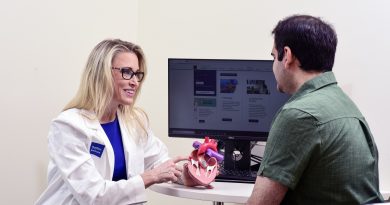Patient’s leg saved by Baylor Medicine surgeon
The situation was dire for Jose Samano. He had a severe infection in his left foot and was told by several surgeons that amputation of his leg was inevitable. Samano had peripheral vascular disease, a condition where blood flow to the limbs is restricted due to narrowing or blockage of blood vessels, which makes wound healing challenging. Despite being told he needed an amputation, he and his wife remained hopeful.
“My wife and I were praying to God to give us a miracle in my leg, and he sent Dr. Coye,” Samano said.

Dr. Tyler Coye, a Baylor Medicine foot surgeon who specializes in limb salvage for patients with diabetes and other conditions, evaluated Samano and saw a possibility to save his leg.
“For many patients, an extremity may be so compromised that we are not able to do very much in terms of treatment for it,” said Coye, assistant professor in the Division of Vascular Surgery and Endovascular Therapy at Baylor. “But there are a large number of patients that I treat who otherwise would have had their legs amputated but do have a chance for success.”
Coye said not only is saving the limb important, but saving a limb that is functional so the patient can walk is the end goal.
“When Dr. Coye came into the room at the hospital, he talked with us,” Samano said. “He explained the process – that it would be long, but he would do whatever was possible to save my leg.”And the process was rigorous. It included multiple surgeries, weeks in the hospital, wound care and many follow-up appointments. But now Samano is walking on the same leg that was very nearly amputated, thanks to Coye and his expertise in saving limbs.
The process Coye employed for Samano was similar to other patients:
Ensure all the infection is removed, including dead tissue and bone
“[Mr. Samano] had lost a large portion of his foot, which makes it a very complicated extremity to treat because, in the long run, we want these patients to be mobile and work well with rehabilitation,” said Coye.
Reconstruct the foot
“After the infection is removed, we look at ways we can reconstruct the foot so they can put it into a shoe or brace as an end goal,” said Coye.
Following the extensive hospital procedure to remove the infection, Coye used unique graft material or embryonic stem cell tissue to reconstruct Samano’s foot. This allowed the patient’s own tissue to incorporate and fill in the defect.
Negative pressure wound therapy
A special machine called a wound vac is placed on top of the graft to help it adhere and help the wound deficit fill in over time.
Close follow-up
Many follow-up appointments monitor the wound to ensure the patient is healing appropriately.
Fitting of shoe or boot
When the wound is healed and cleared for weight bearing, the patient then does physical therapy to re-learn how to walk.
Samano and his wife have had a long journey but are very grateful.
“Thanks to God, Dr. Coye has been a blessing for my husband by operating on his leg. He is an attentive, good man. He really cares about his patients, and I have seen that.”
Watch a video version of this story.
By Tiffany Harston, communications specialist in the Michael E. DeBakey Department of Surgery



